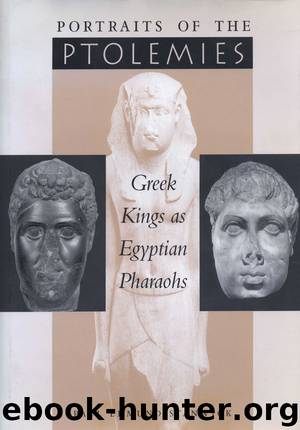Portraits of the Ptolemies: Greek Kings as Egyptian Pharaohs by Stanwick Paul Edmund

Author:Stanwick, Paul Edmund
Language: eng
Format: epub
Tags: -
Publisher: University of Texas Press
Published: 2013-12-12T16:00:00+00:00
CHAPTER 8
A GENERATION OF INNOVATORS
IN THE FAMINE STELE FROM THE PTOLEMAIC PERIOD, the king has a fantastic dream after listening to a priest s teachings.1 He has a vision about the god Khnum, who was famed as a maker of gods, people, and animals, and whose home was Elephantine in Upper Egypt, an area rich in the stones used for royal statuary. Khnum presents the king with an incredible gift—the god’s fabulous mineral wealth. Vitalized by the dream, the newly wakened king takes a number of momentous steps, including empowering sculptors to fashion the stones and minerals into statues.
Some similar instance of priestly inspired ideation must have been behind the transformation that Greek rule brought to Egyptian-style royal portraits. After centuries of measured and subtle development during the Late Period, royal portraiture was decisively altered with the introduction of Greek features, seemingly in the span of a generation. A group of important native sculptors shaped this aggressive break with the past, giving tangible form to the new ideas of the king and his priestly advisors. Like the sculptors of the Famine stele, they are mostly anonymous, but their accomplishments are still visible in their statues.
The obvious achievement of these innovators was the provocative melding of Greek and Egyptian forms. More significant, however, was their attainment of highly individualized artistic expressions based on Greek ideas. Royal portraits not only possess an ideological presence specific to their subjects, but they spotlight the mastery of individual sculptors’ studios. For the reigns of Ptolemies V-VI, there are the idiosyncratic heads in Berlin (B1, B2, B3), the contrasting facial treatments of two granite heads (B6, B7), and the colossal marble face in Alexandria (B27), which is unusual in its mix of Greek and Egyptian and its design for use in a composite statue. These diverse sculptures date within decades of the perfectionist copying of the early Ptolemaic Period, which muted the individual expression of both its subjects and its sculptors. The face of the granite statue of Ptolemy II in the Vatican (A3) imitates fourth-century types and is faithfully repeated in representations in schist (A20), plaster (A21), bronze (A7), limestone (A22), and Egyptian alabaster (A23).
There is a veritable explosion of sculptural styles in the second century. Three different yet interrelated modes can be distinguished.2 The most recognizable is the hellenized mode that uses Greeklike hair and faces to create at least one type for each ruler. The Athens Ptolemy VIII (C5) looks like its marble counterpart (Figs. 256-257). A second mode incorporates Greek ideas, but renders the eyebrows, eyes, and lips in abstract Egyptian terms. The sphinx heads of Ptolemy VIII from Medinet Madi (C3, C4) are examples of this mezzo (“middle”) style, so named because it occupies a middle ground between the hellenized style and more purely Egyptian ones. The third mode builds on native ideas from the fourth and third centuries and avoids Greek interpolations such as hair. Many statues from the dark stone series keep to this traditional style (such as B15, B16, B17).
Download
This site does not store any files on its server. We only index and link to content provided by other sites. Please contact the content providers to delete copyright contents if any and email us, we'll remove relevant links or contents immediately.
The Secret History by Donna Tartt(18159)
Red Sparrow by Jason Matthews(5195)
Harry Potter 02 & The Chamber Of Secrets (Illustrated) by J.K. Rowling(3555)
In a Sunburned Country by Bill Bryson(3365)
Drawing Cutting Edge Anatomy by Christopher Hart(3290)
Figure Drawing for Artists by Steve Huston(3268)
The Daily Stoic by Holiday Ryan & Hanselman Stephen(3109)
Harry Potter and the Prisoner of Azkaban (Book 3) by J. K. Rowling(3109)
Japanese Design by Patricia J. Graham(3000)
The Roots of Romanticism (Second Edition) by Berlin Isaiah Hardy Henry Gray John(2819)
Make Comics Like the Pros by Greg Pak(2757)
Stacked Decks by The Rotenberg Collection(2685)
Harry Potter and the Deathly Hallows (7) by J.K. Rowling(2550)
Draw-A-Saurus by James Silvani(2503)
Tattoo Art by Doralba Picerno(2484)
On Photography by Susan Sontag(2482)
Foreign Devils on the Silk Road: The Search for the Lost Treasures of Central Asia by Peter Hopkirk(2385)
Churchill by Paul Johnson(2360)
The Daily Stoic by Ryan Holiday & Stephen Hanselman(2343)
